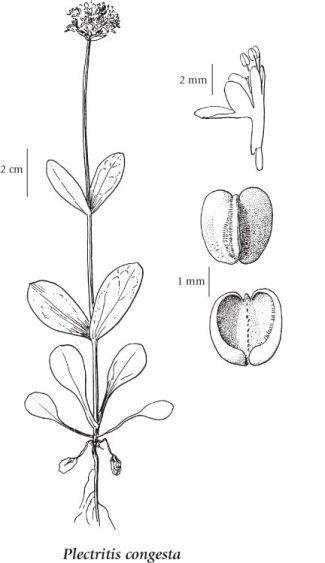Plectritis congesta (Lindl.) DC.
sea blush (black cup fungus; rosy plectritis; shortspur seablush)
Caprifoliaceae (Valerian family)
(Previously in Valerianaceae)
Introduction to Vascular Plants
sea blush (black cup fungus; rosy plectritis; shortspur seablush)
Caprifoliaceae (Valerian family)
(Previously in Valerianaceae)
Introduction to Vascular Plants
SUBTAXA PRESENT IN BC
Plectritis congesta ssp. congesta
Species Information
General:
Annual herb from a taproot; stems erect, solitary, simple, smooth, 10-60 cm tall.
Leaves:
Basal leaves soon deciduous; stem leaves opposite, lowermost leaves spoon-shaped or egg-shaped with short stalks, others more oblong or elliptic and stalkless, smooth, 1-6 cm long, 3-22 mm wide.
Flowers:
Inflorescence of terminal, more or less headlike clusters; corollas white to pale or dark pink 1.5-9.5 mm long, 2-lobed, with a slender spur, the tip usually enlarged; calyces lacking.
Fruits:
Achenes, dry, 2-4 mm long, convex side of body usually keeled, not grooved lengthwise, winged or not, the wing margins not thickened, hairy near the tips or along the margins.
Illustration

If more than one illustration is available for a species (e.g., separate illustrations were provided for two subspecies) then links to the separate images will be provided below. Note that individual subspecies or varietal illustrations are not always available.
Illustration Source: The Illustrated Flora of British Columbia
Ecology
Ecological Framework for Plectritis congesta
The table below shows the species-specific information calculated from
original data (BEC database) provided by the BC Ministry of Forests and Range.
(Updated August, 2013)
The table below shows the species-specific information calculated from
original data (BEC database) provided by the BC Ministry of Forests and Range.
(Updated August, 2013)
| Site Information |
Value / Class |
||
|
Avg |
Min |
Max |
|
| Elevation
(metres) |
161 | 90 | 315 |
| Slope
Gradient (%) |
38 | 3 | 90 |
|
Aspect (degrees) |
164 | 23 | 360 |
| Soil
Moisture Regime (SMR) [0 - very xeric; 4 - mesic; 8 - hydric] |
1 | 0 | 3 |
| Modal
Nutrient Regime
Class |
B | ||
| #
of field plots species was recorded in: |
53 | ||
| Modal
BEC Zone Class |
CDF | ||
|
All BEC Zones (# of stations/zone) species was recorded in |
CDF(19), CWH(2) | ||
|
Source:
Klinkenberg 2013
|
|||